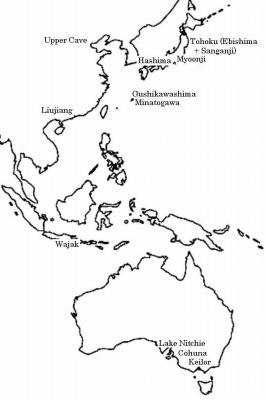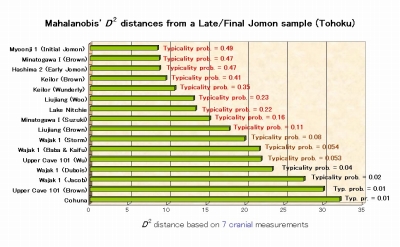[[[[ The Ancestors of the Jomon People Were Not Like Minatogawa I But Like Keilor? ]]]]

Fig. 1. Jomon and Paleolithic specimens compared.
**** 「更新世から縄文・弥生期にかけての日本人の変遷に関する総合的研究」研究班 ****
2008年3月7日更新

Fig. 1. Jomon and Paleolithic specimens compared.
2008年3月7日更新
INTRODUCTION
The "Jomon" people are prehistoric natives of the Japanese Islands. They have been shown by Suzuki (1982) and Brown (1999) to resemble Minatogawa I (a Paleolithic human fossil in Okinawa) and Liujiang (a Paleolithic human fossil in southern China) much more than Upper Cave 101 (a Paleolithic human fossil in northern China). But these are the results based only on cranial measurements. Baba and Endo (1982) and Baba (2002), observing postcranial skeletons, pointed out that the Minatogawa femora considerably differed from those of the Jomon as well as of Upper Cave and Liujiang in the degree of development of the linea aspera.
In the present study, the ancestors of the Jomon people are explored using Mahalanobis' D2 distance from two points of view. One is an attempt to utilize both cranial and femoral measurements for examining what Paleolithic specimen is the closest to the Jomon population. The other trial is to expand the area to be searched for the ancestors of the Jomon people to Australia.
MATERIALS
The Jomon period (ca. 15,400 to 2,800 BP) consists of six phases: Incipient, Initial, Early, Middle, Late and Final phases. In the present analysis, a pooled male sample from the Late and/or Final phases (ca. 4,500 to 2,800 BP) of the Tohoku district (Fig. 1) is used as the representative of the Jomon people. The original samples composing this pooled sample are derived from the Ebishima shell mound, Iwate, and the Sanganji shell mound, Fukushima. The sample size ranges between 11 and 29 from variable to variable (average = 21).
The individual specimens compared with the pooled Jomon sample are as follows (Fig. 1).
METHODS
In order to assess general morphological differences, Mahalanobis’ D2 distances (Rao, 1952; Okuno et al., 1971) were calculated using cranial and femoral measurements or only cranial measurements. Variance/covariance matrices, necessary for calculating Mahalanobis’ D2 distances, were obtained on the basis of the data of 30 modern Japanese males, and used under the assumption that these variance/covariance matrices were the same as those for the Tohoku Jomon population.
When we want to determine whether an individual specimen belongs a reference population, it seems the best way to use the typicality probability (Campbell, 1984; Ambergen and Schaafsma, 1984; Wilson, 1984; Albrecht, 1992) for the present (Fig. 2). In this study, Campbell’s (1984) predictive approach was used to estimate the probability in which a certain fossil specimen is a member of the Tohoku Jomon population.

RESULTS AND DISCUSSION
1) The results based on 14 cranial and 2 femoral measurements (Martin's Nos. 1, 5, 9, 8, 17, 26, 27, 28, 29, 30, 31, 46, 52 and 55; and 6 and 7) show the relatively high possibility that both Minatogawa I and Liujiang are ancestors of the Late/Final Jomon pouplation (Fig. 3, not shown). This supports the previous findings by Suzuki (1982) and Brown (1999) based only on cranial measurements. But, as the number of femoral measurements used is very limited, it should further be examined to what extent the differences in femoral morphology between Minatogawa I and other specimens (Baba and Endo, 1982; Baba, 2002) contribute to distance analyses.
2) The results based on 13 cranial measurements (Martin's Nos. 1, 5, 9, 8, 17, 26, 27, 28, 29, 30, 31, 52 and 55) show that Keilor is a more likely ancestor of the Late/Final Jomon population than Minatogawa I and Liujiang (Fig. 4). This is a new finding.
3) The results based on 7 cranial measurements (Martin's Nos. 1, 5, 8, 17, 29, 30 and 52) show that, even if there are some interobserver errors, not only Minatogawa I and Liujiang but also Australian fossils like Keilor and Lake Nitchie are candidates for the ancestors of the Late/Final Jomon population (Fig. 5).
4) Although Jomon skeletal remains from the Okinawa area are very limited, some cranial data of the Gushikawashima Jomon people have been reported. The results based on 4 cranial measurements (Martin's Nos. 1, 8, 17 and 46) suggest that the Gushikawashima is also a member of the Late/Final Jomon population in the major Japanese island, Honshu (Fig. 6, not shown), as was expected. But, as the number of variables used is too small, the characteristics of the Jomon people in Okinawa and their affinities with other populations should be investigated in more detail in the future.


CONCLUSIONS
The typicality probabilities of Asian and Australian Paleolithic human fossils belonging to the Late/Final Jomon population suggest that Australian specimens like Keilor and Lake Nitchie should also be taken into consideration as candidates for the ancestors of the Jomon people in addition to the Minatogawa and Liujiang materials.
![]() トップページ
トップページ
![]() 旧石器時代人骨の形態と年代の再検討
旧石器時代人骨の形態と年代の再検討
![]() 縄文時代早期人骨の形態学的調査とDNA分析
縄文時代早期人骨の形態学的調査とDNA分析
![]() 北海道出土の縄文・続縄文時代人骨のDNA分析
北海道出土の縄文・続縄文時代人骨のDNA分析
![]() 弥生時代の枠組み変化による日本人起源仮説への影響の検討
弥生時代の枠組み変化による日本人起源仮説への影響の検討
![]() 関東弥生時代人の年代・食性・形態の再検討
関東弥生時代人の年代・食性・形態の再検討
![]() 頭蓋・四肢骨計測値の地理的変異パターンにおける時代間差の分析
頭蓋・四肢骨計測値の地理的変異パターンにおける時代間差の分析